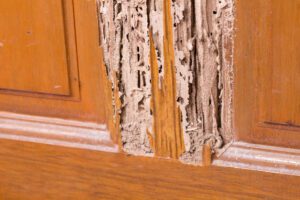
Ignoring Pest Control? Here’s How It Could Be Draining Your Wallet
Many homeowners choose to ignore pest problems or opt for do-it-yourself solutions to save money. However, neglecting professional pest control can actually lead to higher costs down the line. Pests like termites, rodents, and carpenter ants aren’t just nuisances—they can cause significant damage to your home, leading to expensive repairs. Here’s a deeper look into how ignoring pest control can end up costing you more than you might expect.
Structural Damage
Structural damage caused by pests is one of the most significant and costly issues homeowners can face. Certain pests have the potential to compromise the integrity of your home without you even noticing until extensive repairs are needed. Here’s an in-depth look at how pests contribute to structural damage, and which ones are most notorious for it.
The Silent Destroyers: Termites
Termites are often called the silent destroyers because they can chew through wood, flooring, and even wallpaper undetected. These pests primarily feed on cellulose, a part of wood, making homes a perfect feast for them. There are several species of termites, but in the U.S., the most destructive are the subterranean and drywood termites.
- Subterranean Termites are the most widespread and destructive in the U.S. They build their colonies underground and can enter a home through its foundation, consuming wood from the inside out. They thrive particularly in warmer climates and are prevalent in the Southeastern states.
- Drywood Termites infest dry wood directly and are commonly found in the coastal, southern, and particularly dry regions of the U.S., such as Southern California and the desert areas of Texas and Arizona.
Other Wood-Boring Pests
While termites are the most notorious for causing structural damage, they are not alone. Carpenter ants and certain beetles also pose threats to wooden structures.
- Carpenter Ants excavate wood to build their nests, which can weaken the structural timbers. Unlike termites, they do not consume the wood but remove it to create space for their colonies. These ants are commonly found in the Pacific Northwest and the Northeastern United States, where the climate is cooler and moisture levels higher.
- Powderpost Beetles can also cause significant damage as their larvae bore through wood, which can lead to structural weakness. These beetles are a particular problem in areas with high humidity.

Cost Implications:
- Termites: Repairing termite damage can be extremely expensive, with the average repair costs ranging from $3,000 to over $7,000, depending on the extent of the damage and the size of your home.
- Carpenter Ants and Bees: These pests can also compromise the structural integrity of your home by burrowing into wood to create nests. Over time, their activities can weaken beams and posts, leading to costly repairs.
Damaged Wiring
When considering pest-related damages in homes, wiring might not be the first thing that comes to mind. However, certain pests pose a significant risk to electrical systems, which can lead to costly repairs and even dangerous fire hazards. Understanding how these issues arise is crucial for homeowners looking to protect their investments and ensure safety.
The Primary Culprits: Rodents
Rodents such as mice and rats are notorious for causing wiring damage within homes. Their need to gnaw on materials to manage tooth growth makes electrical wiring a prime target. This activity typically happens in areas less frequented by humans—attics, crawl spaces, and behind walls—where rodents can chew on wires undisturbed, leading to serious risks.
Risks of Exposed Wiring
The gnawing behavior of rodents can strip away the insulation around electrical wires, exposing the conductive metals. This exposure greatly increases the risk of electrical hazards, such as short circuits and fires, which can lead to catastrophic outcomes including house fires.
Secondary Damages and Functional Disruptions
Damaged wiring doesn’t just pose safety risks; it also affects the functionality of your home’s systems. Exposed or damaged wires can cause power outages, affect the efficiency of heating and cooling systems, and disrupt the operation of appliances. These issues necessitate professional repairs, adding further costs and inconvenience to homeowners.
Attracting Additional Pests
Compromised wiring insulation can attract other pests, particularly certain insects drawn to the electrical fields and warmth. This not only exacerbates the initial problem but can lead to more severe electrical issues, creating a vicious cycle of pest-related damage.

Preventive Measures and Solutions
To mitigate these risks, homeowners should take proactive steps such as sealing potential entry points to prevent rodents from entering the home. Regular inspections of susceptible areas like attics and basements are crucial for early detection of infestations. Moreover, employing professional pest control services can be an effective strategy to manage and eliminate rodent populations, protecting the electrical integrity of the home.
Cost Implications:
- Fire Risk: The cost of repairing fire damage can be astronomical, not to mention the potential danger to your family’s safety.
- Appliance Failure: If pests damage the wiring to major appliances, the cost to repair or replace these can quickly add up.
Health Costs
Pests like cockroaches, rodents, and mosquitoes aren’t just irritants; they carry diseases that can affect the health of your family. The presence of pests in your home can lead to food contamination, allergic reactions, and even illnesses such as hantavirus, salmonellosis, and Lyme disease.
Cost Implications:
- Medical Bills: Treating diseases or allergies caused by pests can result in medical bills and lost wages if you’re too sick to work.
- Preventive Measures: Ongoing costs for medications and preventive treatments can also add up if pests aren’t eradicated properly.
Furniture and Clothing Damage
Certain pests, including moths, carpet beetles, and silverfish, are notorious for ruining clothing, upholstery, and other fabrics. These pests can cause considerable damage before they are even detected.
Cost Implications:
- Replacement and Repair: The cost to replace damaged clothing, furniture, and carpets can be significant, particularly if the items are of high value or sentimental worth.

Decreased Home Value
If you’re planning to sell your home, the presence of an active or past pest infestation can drastically reduce its market value. Potential buyers are likely to be deterred by signs of pest problems, or they may demand a lower price if they perceive the risk of future infestations.
Cost Implications:
- Home Value: You might have to sell your home for less than its potential market value if evidence of pest damage is found during the inspection process.
- Remediation Costs: You may also need to invest in extensive pest control measures and repairs before putting your home on the market.
While it might seem cost-effective to skip professional pest control, the long-term financial risks of doing so can be substantial. Investing in regular, professional pest control services not only helps prevent the aforementioned issues but also provides peace of mind knowing that your home and health are protected from the destructive and costly impact of pests. Remember, when it comes to pests, prevention is always better—and often cheaper—than the cure.
Now that you understand the hidden costs of ignoring pest control, let’s delve into how much it actually costs to manage and eliminate pest problems with professional services. Knowing the potential expense involved can help you budget appropriately and make informed decisions about protecting your home.
Overview of Pest Control Service Costs
The cost of pest control services can vary widely based on several factors including the type of pest, severity of the infestation, size of your property, and the region you live in. Here’s a breakdown of what you might expect:
Routine Pest Control
For general pest control, covering common pests such as ants, spiders, and cockroaches, homeowners can expect to pay between $100 to $300 per visit. Typically, a pest control service will recommend a schedule of regular visits — monthly, bi-monthly, or quarterly — to ensure that pests are kept in check over time.
Specific Infestations
The cost can rise significantly when dealing with specific pests that require more intensive treatment strategies:
- Termites: Treatment for termites can range from $500 to $2,500, depending on the infestation size and the treatment type (baiting systems, chemical treatments, etc.). Full house fumigation can go even higher, potentially costing several thousand dollars.
- Bed Bugs: Getting rid of bed bugs usually involves detailed work and can cost anywhere from $500 to $1,500, depending on the level of infestation and the size of the affected area.
- Rodents: Rodent removal typically ranges from $200 to $500 for initial removal and exclusion techniques to prevent re-entry. This cost can increase if extensive cleanup or repairs are necessary due to damage caused by the rodents.

Annual Contracts
Many pest control companies offer annual contracts that provide periodic inspections and treatment as needed. These can be more cost-effective than one-off treatments, averaging $400 to $1,000 per year, depending on the services included.
Additional Cost Factors
- Follow-up Visits: Some infestations may require multiple treatments or follow-up visits which can add to the total cost.
- Preventative Measures: Investing in preventative measures like sealing cracks, installing screens, or employing moisture control can incur additional costs but save money in the long run by preventing future infestations.
- Home Size and Accessibility: Larger homes or properties with complex structures may incur higher charges due to the greater amount of materials and labor required.
- Geographic Location: Costs can also vary by location, with urban areas typically facing higher service charges than rural areas due to higher operating costs for businesses in cities.
Considerations for Budgeting
When planning for pest control expenses, consider the potential cost of not taking action. Structural repairs, replacement of damaged goods, and health issues can all surpass the cost of preventative and reactive pest control services.
Moreover, compare service plans and quotes from multiple pest control companies to ensure you receive competitive pricing and comprehensive service. Be sure to check reviews and confirm that the company is licensed and insured, providing assurance of quality and reliability.
Investing in professional pest control is a proactive way to protect your property and health from the damages pests can cause. While there is an upfront cost, the long-term savings from avoiding more severe pest-related damages can make these services a wise financial decision. Understanding the costs involved and planning accordingly can help you maintain a pest-free home without unexpected financial burdens.


Leave a Reply